Antibacterial and Antibiofilm Activity of Green-Synthesized Zinc Oxide Nanoparticles Against Multidrug-Resistant Escherichia coli Isolated from Retail Fish
Abstract
1. Introduction
2. Results and Discussion
2.1. Incidence and Characterization of E. coli in Marketed Fish
2.2. Characterization of Green Synthesized ZnO-NPs
2.3. ZnO-NPs’ Antibacterial and Antibiofilm Activity
2.4. ZnO-NPs’ Antibacterial Mechanism
3. Materials and Methods
3.1. Sample Collection and E. coli Isolation
3.2. Antibiotic Susceptibility Testing
3.3. Molecular Characterization
3.4. ZnO-NP Synthesis
3.4.1. Phytochemical Analysis of S. rebaudiana
3.4.2. Characterization of the Green Synthesized ZnO-NPs
3.5. ZnO-NPs’ Bioactivity Against Pathogenic MDR E. coli Strains
3.5.1. Antibacterial Activity
3.5.2. Antibiofilm Activity
3.6. ZnO-NP Mechanism as an Antibacterial Agent
3.6.1. Changes in Bacterial Morphological Characteristics
3.6.2. Cell Membrane Integrity
3.6.3. Changes in Bacterial Cell DNA Content
3.7. Statistical Analysis
4. Conclusions
Supplementary Materials
Author Contributions
Funding
Institutional Review Board Statement
Informed Consent Statement
Data Availability Statement
Acknowledgments
Conflicts of Interest
References
- Jim, F.; Garamumhango, P.; Musara, C. Comparative Analysis of Nutritional Value of Oreochromis niloticus (Linnaeus), Nile Tilapia, Meat from Three Different Ecosystems. J. Food Qual. 2017, 2017, 6714347. [Google Scholar] [CrossRef]
- Nuryanto, N.; Afifah, D.N.; Sulchan, M.; Martosuyono, P.; Ihsani, K.; Kurniastuti, P.L. Potential of Nile Tilapia (Oreochromis niloticus) as an Alternative Complementary Food Ingredient for Stunting Children. Open Access Maced. J. Med. Sci. 2022, 10, 1170–1177. [Google Scholar] [CrossRef]
- Furuya, W.M.; da Cruz, T.P.; Gatlin, D.M., 3rd. Amino Acid Requirements for Nile Tilapia: An Update. Animals 2023, 13, 900. [Google Scholar] [CrossRef] [PubMed]
- Enany, M.E.; Algammal, A.M.; Nasef, S.A.; Abo-Eillil, S.A.M.; Bin-Jumah, M.; Taha, A.E.; Allam, A.A. The Occurrence of the Multidrug Resistance (MDR) and the Prevalence of Virulence Genes and QACs Resistance Genes in E. Coli Isolated from Environmental and Avian Sources. AMB Express 2019, 9, 192. [Google Scholar] [CrossRef] [PubMed]
- Al-Ghanayem, A.; Joseph, B.; Mahdi, M.B.; Scaria, B.; Saadabi, A.M. Multidrug Resistance Pattern of Bacteria Isolated from Fish Samples Sold in Retail Market. J. Clin. Diagn. Res. 2020, 14, 13–16. [Google Scholar] [CrossRef]
- Gufe, C.; Canaan Hodobo, T.; Mbonjani, B.; Majonga, O.; Marumure, J.; Musari, S.; Jongi, G.; Makaya, P.V.; Machakwa, J. Antimicrobial Profiling of Bacteria Isolated from Fish Sold at Informal Market in Mufakose, Zimbabwe. Int. J. Microbiol. 2019, 2019, 8759636. [Google Scholar] [CrossRef]
- Okyere, A.; Bishoff, D.; Oyaro, M.O.; Ajami, N.J.; Darkoh, C. Analysis of Fish Commonly Sold in Local Supermarkets Reveals the Presence of Pathogenic and Multidrug-Resistant Bacterial Communities. Microbiol. Insights 2018, 11, 1178636118786925. [Google Scholar] [CrossRef]
- Dutta, C. Prevalence of Escherichia coli in Fish and Shrimps Obtained from Retail Fish Markets in & around Kolkata, India. Front. Environ. Microbiol. 2016, 2, 1. [Google Scholar] [CrossRef][Green Version]
- Abdelbaky, A.S.; Abd El-Mageed, T.A.; Babalghith, A.O.; Selim, S.; Mohamed, A.M.H.A. Green Synthesis and Characterization of ZnO Nanoparticles Using Pelargonium odoratissimum (L.) Aqueous Leaf Extract and Their Antioxidant, Antibacterial and Anti-Inflammatory Activities. Antioxidants 2022, 11, 1444. [Google Scholar] [CrossRef]
- Sana, S.S.; Kumbhakar, D.V.; Pasha, A.; Pawar, S.C.; Grace, A.N.; Singh, R.P.; Nguyen, V.-H.; Le, Q.V.; Peng, W. Crotalaria Verrucosa Leaf Extract Mediated Synthesis of Zinc Oxide Nanoparticles: Assessment of Antimicrobial and Anticancer Activity. Molecules 2020, 25, 4896. [Google Scholar] [CrossRef]
- Singh, T.A.; Sharma, A.; Tejwan, N.; Ghosh, N.; Das, J.; Sil, P.C. A State of the Art Review on the Synthesis, Antibacterial, Antioxidant, Antidiabetic and Tissue Regeneration Activities of Zinc Oxide Nanoparticles. Adv. Colloid Interface Sci. 2021, 295, 102495. [Google Scholar] [CrossRef]
- Atapakala, S.; Sana, S.S.; Kuppam, B.; Varma, R.S.; Aly Saad Aly, M.; Kim, S.-C.; Vadde, R. Honey Mediated Synthesis of Zinc Oxide Nanoparticles, and Evaluation of Antimicrobial, Antibiofilm Activities against Multidrug Resistant Clinical Bacterial Isolates. J. Ind. Eng. Chem. 2024, 135, 110–121. [Google Scholar] [CrossRef]
- Guirguis, H.A.; Youssef, N.; William, M.; Abdel-Dayem, D.; El-Sayed, M.M.H. Bioinspired Stevia Rebaudiana Green Zinc Oxide Nanoparticles for the Adsorptive Removal of Antibiotics from Water. ACS Omega 2024, 9, 12881–12895. [Google Scholar] [CrossRef] [PubMed]
- Lahiri, D.; Ray, R.R.; Sarkar, T.; Upadhye, V.J.; Ghosh, S.; Pandit, S.; Pati, S.; Edinur, H.A.; Abdul Kari, Z.; Nag, M.; et al. Anti-Biofilm Efficacy of Green-Synthesized ZnO Nanoparticles on Oral Biofilm: In Vitro and in Silico Study. Front. Microbiol. 2022, 13, 939390. [Google Scholar] [CrossRef] [PubMed]
- Nair, G.M.; Sajini, T.; Mathew, B. Advanced Green Approaches for Metal and Metal Oxide Nanoparticles Synthesis and Their Environmental Applications. Talanta Open 2022, 5, 100080. [Google Scholar] [CrossRef]
- Naiel, B.; Fawzy, M.; Halmy, M.W.A.; Mahmoud, A.E.D. Green Synthesis of Zinc Oxide Nanoparticles Using Sea Lavender (Limonium pruinosum L. Chaz.) Extract: Characterization, Evaluation of Anti-Skin Cancer, Antimicrobial and Antioxidant Potentials. Sci. Rep. 2022, 12, 20370. [Google Scholar] [CrossRef]
- Sadeghi, B.; Mohammadzadeh, M.; Babakhani, B. Green Synthesis of Gold Nanoparticles Using Stevia Rebaudiana Leaf Extracts: Characterization and Their Stability. J. Photochem. Photobiol. B Biol. 2015, 148, 101–106. [Google Scholar] [CrossRef]
- Husain, F.M.; Qais, F.A.; Ahmad, I.; Hakeem, M.J.; Baig, M.H.; Masood Khan, J.; Al-Shabib, N.A. Biosynthesized Zinc Oxide Nanoparticles Disrupt Established Biofilms of Pathogenic Bacteria. Appl. Sci. 2022, 12, 710. [Google Scholar] [CrossRef]
- Naseer, M.; Aslam, U.; Khalid, B.; Chen, B. Green Route to Synthesize Zinc Oxide Nanoparticles Using Leaf Extracts of Cassia Fistula and Melia Azadarach and Their Antibacterial Potential. Sci. Rep. 2020, 10, 9055. [Google Scholar] [CrossRef]
- Sifuna, A.W.; Njagi, N.M.; Okemo, P.; Munyalo, A.; Orinda, G.O.; Kariuki, S. Microbiological Quality and Safety of Rastrineobola argentea Retailed in Kisumu Town Markets, Kenya. East Afr. Med. J. 2009, 85, 509–513. [Google Scholar] [CrossRef][Green Version]
- Thampuran, N.; Surendraraj, A.; Surendran, P.K. Prevalence and Characterization of Typical and Atypical Escherichia coli from Fish Sold at Retail in Cochin, India. J. Food Prot. 2005, 68, 2208–2211. [Google Scholar] [CrossRef] [PubMed]
- Ribeiro, L.F.; Barbosa, M.M.C.; de Rezende Pinto, F.; Guariz, C.S.L.; Maluta, R.P.; Rossi, J.R.; Rossi, G.A.M.; Lemos, M.V.F.; do Amaral, L.A. Shiga Toxigenic and Enteropathogenic Escherichia coli in Water and Fish from Pay-to-Fish Ponds. Lett. Appl. Microbiol. 2016, 62, 216–220. [Google Scholar] [CrossRef] [PubMed]
- Siddhnath, K.; Majumdar, R.K.; Parhi, J.; Sharma, S.; Mehta, N.K.; Laishram, M. Detection and Characterization of Shiga Toxin-Producing Escherichia coli from Carps from Integrated Aquaculture System. Aquaculture 2018, 487, 97–101. [Google Scholar] [CrossRef]
- Joseph, A.; Cointe, A.; Mariani Kurkdjian, P.; Rafat, C.; Hertig, A. Shiga Toxin-Associated Hemolytic Uremic Syndrome: A Narrative Review. Toxins 2020, 12, 67. [Google Scholar] [CrossRef] [PubMed]
- Kumar M, N.; Bhat, S.; Bhat K, A.; Saralaya, V.; Shenoy Mulki, S. Characterization of Virulence Factors and Antibiotic Resistance Pattern of Uropathogenic Escherichia coli Strains in a Tertiary Care Center. F1000Research 2022, 11, 1163. [Google Scholar] [CrossRef]
- Saffioti, N.A.; Lauri, N.; Cané, L.; Gonzalez-Lebrero, R.; Alleva, K.; Mouro-Chanteloup, I.; Ostuni, M.A.; Herlax, V.; Schwarzbaum, P.J. Interactive Dynamics of Cell Volume and Cell Death in Human Erythrocytes Exposed to α-Hemolysin from Escherichia coli. Int. J. Mol. Sci. 2022, 23, 872. [Google Scholar] [CrossRef]
- Llorente, M.T.; Escudero, R.; Ramiro, R.; Remacha, M.A.; Martínez-Ruiz, R.; Galán-Sánchez, F.; de Frutos, M.; Elía, M.; Onrubia, I.; Sánchez, S. Enteroaggregative Escherichia coli as Etiological Agent of Endemic Diarrhea in Spain: A Prospective Multicenter Prevalence Study with Molecular Characterization of Isolates. Front. Microbiol. 2023, 14, 1120285. [Google Scholar] [CrossRef]
- Raghu, A.; Velayudhannair, K. Phytochemical Analysis and Antibacterial Potential of Stevia Rebaudiana (Bertoni, 1899) Leaf Extracts against Aeromonas Species: Influence of Extraction Methods and Solvents in Aquaculture Applications. J. Pure Appl. Microbiol. 2023, 17, 2352–2366. [Google Scholar] [CrossRef]
- Marouzi, S.; Sabouri, Z.; Darroudi, M. Greener Synthesis and Medical Applications of Metal Oxide Nanoparticles. Ceram. Int. 2021, 47, 19632–19650. [Google Scholar] [CrossRef]
- Malekkiani, M.; Heshmati Jannat Magham, A.; Ravari, F.; Dadmehr, M. Facile Fabrication of Ternary MWCNTs/ZnO/Chitosan Nanocomposite for Enhanced Photocatalytic Degradation of Methylene Blue and Antibacterial Activity. Sci. Rep. 2022, 12, 5927. [Google Scholar] [CrossRef]
- Volkov, D.; Rogova, O.; Proskurnin, M. Temperature Dependences of IR Spectra of Humic Substances of Brown Coal. Agronomy 2021, 11, 1822. [Google Scholar] [CrossRef]
- Dorneles, M.S.; de Azevedo, E.S.; Noreña, C.P.Z. Effect of Incorporating Modified Pinhão Starch in Alginate-Based Hydrogel Beads for Encapsulation of Bioactive Compounds by Hydrodynamic Electrospray Ionization Jetting. Int. J. Biol. Macromol. 2024, 267, 131555. [Google Scholar] [CrossRef] [PubMed]
- El-Belely, E.F.; Farag, M.M.S.; Said, H.A.; Amin, A.S.; Azab, E.; Gobouri, A.A.; Fouda, A. Green Synthesis of Zinc Oxide Nanoparticles (ZnO-NPs) Using Arthrospira Platensis (Class: Cyanophyceae) and Evaluation of Their Biomedical Activities. Nanomaterials 2021, 11, 95. [Google Scholar] [CrossRef] [PubMed]
- Pal, D.; Chakraborty, S. A Matrix Isolation Infrared Spectroscopic Study of Thermal Isomerisation of 1-Butanol. Chem. Phys. Lett. 2021, 775, 138617. [Google Scholar] [CrossRef]
- Elrefaey, A.; El-Gamal, A.; Hamed, S.; El-belely, E. Algae-Mediated Biosynthesis of Zinc Oxide Nanoparticles from Cystoseira Crinite (Fucales; Sargassaceae) and It’s Antimicrobial and Antioxidant Activities. Egypt. J. Chem. 2022, 65, 231–240. [Google Scholar] [CrossRef]
- Khatami, M.; Alijani, H.Q.; Heli, H.; Sharifi, I. Rectangular Shaped Zinc Oxide Nanoparticles: Green Synthesis by Stevia and Its Biomedical Efficiency. Ceram. Int. 2018, 44, 15596–15602. [Google Scholar] [CrossRef]
- Matinise, N.; Fuku, X.G.; Kaviyarasu, K.; Mayedwa, N.; Maaza, M. ZnO Nanoparticles via Moringa Oleifera Green Synthesis: Physical Properties & Mechanism of Formation. Appl. Surf. Sci. 2017, 406, 339–347. [Google Scholar] [CrossRef]
- Jiang, A.; Awasthi, N.; Kolmogorov, A.N.; Setyawan, W.; Börjesson, A.; Bolton, K.; Harutyunyan, A.R.; Curtarolo, S. Theoretical Study of the Thermal Behavior of Free and Alumina-Supported Fe-C Nanoparticles. Phys. Rev. B 2007, 75, 205426. [Google Scholar] [CrossRef]
- Fernandes, D.M.; Silva, R.; Hechenleitner, A.A.W.; Radovanovic, E.; Melo, M.A.C.; Pineda, E.A.G. Synthesis and Characterization of ZnO, CuO and a Mixed Zn and Cu Oxide. Mater. Chem. Phys. 2009, 115, 110–115. [Google Scholar] [CrossRef]
- Ungár, T.; Tichy, G.; Gubicza, J.; Hellmig, R.J. Correlation between Subgrains and Coherently Scattering Domains. Powder Diffr. 2005, 20, 366–375. [Google Scholar] [CrossRef]
- Mourdikoudis, S.; Pallares, R.M.; Thanh, N.T.K. Characterization Techniques for Nanoparticles: Comparison and Complementarity upon Studying Nanoparticle Properties. Nanoscale 2018, 10, 12871–12934. [Google Scholar] [CrossRef] [PubMed]
- Jia, Z.; Li, J.; Gao, L.; Yang, D.; Kanaev, A. Dynamic Light Scattering: A Powerful Tool for In Situ Nanoparticle Sizing. Colloids Interfaces 2023, 7, 15. [Google Scholar] [CrossRef]
- Alam, M. Analyses of Biosynthesized Silver Nanoparticles Produced from Strawberry Fruit Pomace Extracts in Terms of Biocompatibility, Cytotoxicity, Antioxidant Ability, Photodegradation, and in-Silico Studies. J. King Saud Univ. Sci. 2022, 34, 102327. [Google Scholar] [CrossRef]
- Yassin, M.T.; Mostafa, A.A.-F.; Al-Askar, A.A.; Al-Otibi, F.O. Facile Green Synthesis of Zinc Oxide Nanoparticles with Potential Synergistic Activity with Common Antifungal Agents against Multidrug-Resistant Candidal Strains. Crystals 2022, 12, 774. [Google Scholar] [CrossRef]
- Ahmad, I.; Alshahrani, M.Y.; Wahab, S.; Al-Harbi, A.I.; Nisar, N.; Alraey, Y.; Alqahtani, A.; Mir, M.A.; Irfan, S.; Saeed, M. Zinc Oxide Nanoparticle: An Effective Antibacterial Agent against Pathogenic Bacterial Isolates. J. King Saud Univ. Sci. 2022, 34, 102110. [Google Scholar] [CrossRef]
- Husain, F.M.; Hasan, I.; Qais, F.A.; Khan, R.A.; Alam, P.; Alsalme, A. Fabrication of Zinc Oxide-Xanthan Gum Nanocomposite via Green Route: Attenuation of Quorum Sensing Regulated Virulence Functions and Mitigation of Biofilm in Gram-Negative Bacterial Pathogens. Coatings 2020, 10, 1190. [Google Scholar] [CrossRef]
- Faisal, S.; Jan, H.; Shah, S.A.; Shah, S.; Khan, A.; Akbar, M.T.; Rizwan, M.; Jan, F.; Wajidullah; Akhtar, N.; et al. Green Synthesis of Zinc Oxide (ZnO) Nanoparticles Using Aqueous Fruit Extracts of Myristica Fragrans: Their Characterizations and Biological and Environmental Applications. ACS Omega 2021, 6, 9709–9722. [Google Scholar] [CrossRef]
- Jayachandran, A.; T R, A.; Nair, A.S. Green Synthesis and Characterization of Zinc Oxide Nanoparticles Using Cayratia Pedata Leaf Extract. Biochem. Biophys. Rep. 2021, 26, 100995. [Google Scholar] [CrossRef]
- Rosenberg, M.; Visnapuu, M.; Vija, H.; Kisand, V.; Kasemets, K.; Kahru, A.; Ivask, A. Selective Antibiofilm Properties and Biocompatibility of Nano-ZnO and Nano-ZnO/Ag Coated Surfaces. Sci. Rep. 2020, 10, 13478. [Google Scholar] [CrossRef]
- Joe, A.; Park, S.-H.; Shim, K.-D.; Kim, D.-J.; Jhee, K.-H.; Lee, H.-W.; Heo, C.-H.; Kim, H.-M.; Jang, E.-S. Antibacterial Mechanism of ZnO Nanoparticles under Dark Conditions. J. Ind. Eng. Chem. 2017, 45, 430–439. [Google Scholar] [CrossRef]
- Yang, H.; Zhang, J.; Li, Z.; Huang, J.; Wu, J.; Zhang, Y.; Ge, H.; Zhao, Y. Antibacterial Effect of Low-Concentration ZnO Nanoparticles on Sulfate-Reducing Bacteria under Visible Light. Nanomaterials 2023, 13, 2033. [Google Scholar] [CrossRef] [PubMed]
- Agarwal, H.; Menon, S.; Kumar, S.V.; Rajeshkumar, S. Mechanistic Study on Antibacterial Action of Zinc Oxide Nanoparticles Synthesized Using Green Route. Chem. Biol. Interact. 2018, 286, 60–70. [Google Scholar] [CrossRef] [PubMed]
- Agyemang, K.; Ofori Donkor, P.; Ayim, I.; Adzitey, F.; Lin, L.; Cui, H. Retracted: Antibacterial Activity and Mechanism of Tetrapleura tetraptera Stem Extract against Salmonella Strains and Its Application in Raw Chicken Meat. J. Food Process. Preserv. 2020, 45, e14489. [Google Scholar] [CrossRef]
- York, M.K.; Baron, E.J.; Clarridge, J.E.; Thomson, R.B.; Weinstein, M.P. Multilaboratory Validation of Rapid Spot Tests for Identification of Escherichia coli. J. Clin. Microbiol. 2000, 38, 3394–3398. [Google Scholar] [CrossRef]
- CLSI. Performance Standards for Antimicrobial Susceptibility Testing, 27th ed.; CLSI Supplement M10; Clinical Laboratory Standards Institute: Wayne, PA, USA, 2017. [Google Scholar]
- Walkty, A.; Karlowsky, J.A.; Lagacé-Wiens, P.R.S.; Baxter, M.R.; Adam, H.J.; Bay, D.C.; Zhanel, G.G. Moving towards a Standardized Definition of Antimicrobial Resistance: A Comparison of the Antimicrobial Susceptibility Profile of Difficult-to-Treat Resistance (DTR) versus Multidrug-Resistant (MDR) Pseudomonas Aeruginosa Clinical Isolates (CANWARD, 2016–2021). Diagn. Microbiol. Infect. Dis. 2024, 108, 116130. [Google Scholar] [CrossRef]
- Ayandele, A.A.; Oladipo, E.K.; Oyebisi, O.; Kaka, M.O. Prevalence of Multi-Antibiotic Resistant Escherichia coli and Klebsiella Species Obtained from a Tertiary Medical Institution in Oyo State, Nigeria. Qatar Med. J. 2020, 2020, 9. [Google Scholar] [CrossRef]
- Moemen, D.; Masallat, D.T. Prevalence and Characterization of Carbapenem-Resistant Klebsiella pneumoniae Isolated from Intensive Care Units of Mansoura University Hospitals. Egypt. J. Basic Appl. Sci. 2017, 4, 37–41. [Google Scholar] [CrossRef][Green Version]
- Sano, H.; Wakui, A.; Kawachi, M.; Washio, J.; Abiko, Y.; Mayanagi, G.; Yamaki, K.; Tanaka, K.; Takahashi, N.; Sato, T. Profiling System of Oral Microbiota Utilizing Polymerase Chain Reaction-Restriction Fragment Length Polymorphism Analysis. J. Oral Biosci. 2021, 63, 292–297. [Google Scholar] [CrossRef]
- Birošová, E.; Siegfried, L.; Kmet’ová, M.; Makara, A.; Ostró, A.; Grešová, A.; Urdzík, P.; Liptáková, A.; Molokáčová, M.; Bártl, R.; et al. Detection of Virulence Factors in α-Haemolytic Escherichia coli Strains Isolated from Various Clinical Materials. Clin. Microbiol. Infect. 2004, 10, 569–573. [Google Scholar] [CrossRef]
- Boerlin, P.; Travis, R.; Gyles, C.L.; Reid-Smith, R.; Janecko, N.; Lim, H.; Nicholson, V.; McEwen, S.A.; Friendship, R.; Archambault, M. Antimicrobial Resistance and Virulence Genes of Escherichia coli Isolates from Swine in Ontario. Appl. Environ. Microbiol. 2005, 71, 6753–6761. [Google Scholar] [CrossRef]
- Dipineto, L.; Santaniello, A.; Fontanella, M.; Lagos, K.; Fioretti, A.; Menna, L.F. Presence of Shiga Toxin-Producing Escherichia coli O157:H7 in Living Layer Hens. Lett. Appl. Microbiol. 2006, 43, 293–295. [Google Scholar] [CrossRef]
- Gheorghe, I.; Czobor, I.; Chifiriuc, M.C.; Borcan, E.; Ghiţă, C.; Banu, O.; Lazăr, V.; Mihăescu, G.; Mihăilescu, D.F.; Zhiyong, Z. Molecular Screening of Carbapenemase-Producing Gram-Negative Strains in Romanian Intensive Care Units during a One Year Survey. J. Med. Microbiol. 2014, 63, 1303–1310. [Google Scholar] [CrossRef] [PubMed]
- Maynard, C.; Bekal, S.; Sanschagrin, F.; Levesque, R.C.; Brousseau, R.; Masson, L.; Larivière, S.; Harel, J. Heterogeneity among Virulence and Antimicrobial Resistance Gene Profiles of Extraintestinal Escherichia coli Isolates of Animal and Human Origin. J. Clin. Microbiol. 2004, 42, 5444–5452. [Google Scholar] [CrossRef]
- Müller, D.; Greune, L.; Heusipp, G.; Karch, H.; Fruth, A.; Tschäpe, H.; Schmidt, M.A. Identification of Unconventional Intestinal Pathogenic Escherichia coli Isolates Expressing Intermediate Virulence Factor Profiles by Using a Novel Single-Step Multiplex PCR. Appl. Environ. Microbiol. 2007, 73, 3380–3390. [Google Scholar] [CrossRef] [PubMed]
- Rodriguez-Siek, K.E.; Giddings, C.W.; Doetkott, C.; Johnson, T.J.; Nolan, L.K. Characterizing the APEC Pathotype. Vet. Res. 2005, 36, 241–256. [Google Scholar] [CrossRef] [PubMed]
- Wang, G.; Clark, C.G.; Rodgers, F.G. Detection in Escherichia coli of the Genes Encoding the Major Virulence Factors, the Genes Defining the O157:H7 Serotype, and Components of the Type 2 Shiga Toxin Family by Multiplex PCR. J. Clin. Microbiol. 2002, 40, 3613–3619. [Google Scholar] [CrossRef]
- Essa, H.L.; Abdelfattah, M.S.; Marzouk, A.S.; Guirguis, H.A.; El-Sayed, M.M.H. Nano-Formulations of Copper Species Coated with Sulfated Polysaccharide Extracts and Assessment of Their Phytotoxicity on Wheat (Triticum aestivum L.) Seedlings in Seed Germination, Foliar and Soil Applications. Appl. Sci. 2020, 10, 6302. [Google Scholar] [CrossRef]
- Schindelin, J.; Arganda-Carreras, I.; Frise, E.; Kaynig, V.; Longair, M.; Pietzsch, T.; Preibisch, S.; Rueden, C.; Saalfeld, S.; Schmid, B.; et al. Fiji: An Open-Source Platform for Biological-Image Analysis. Nat. Methods 2012, 9, 676–682. [Google Scholar] [CrossRef]
- Yang, C.-C.; Hung, C.-F.; Chen, B.-H. Preparation of Coffee Oil-Algae Oil-Based Nanoemulsions and the Study of Their Inhibition Effect on UVA-Induced Skin Damage in Mice and Melanoma Cell Growth. Int. J. Nanomed. 2017, 12, 6559–6580. [Google Scholar] [CrossRef]
- Mohanta, Y.K.; Biswas, K.; Jena, S.K.; Hashem, A.; Abd Allah, E.F.; Mohanta, T.K. Anti-Biofilm and Antibacterial Activities of Silver Nanoparticles Synthesized by the Reducing Activity of Phytoconstituents Present in the Indian Medicinal Plants. Front. Microbiol. 2020, 11, 1143. [Google Scholar] [CrossRef]
- Zhang, Y.; Liu, X.; Wang, Y.; Jiang, P.; Quek, S. Antibacterial Activity and Mechanism of Cinnamon Essential Oil against Escherichia coli and Staphylococcus aureus. Food Control 2016, 59, 282–289. [Google Scholar] [CrossRef]
- Cui, H.; Zhang, C.; Li, C.; Lin, L. Antibacterial Mechanism of Oregano Essential Oil. Ind. Crops Prod. 2019, 139, 111498. [Google Scholar] [CrossRef]
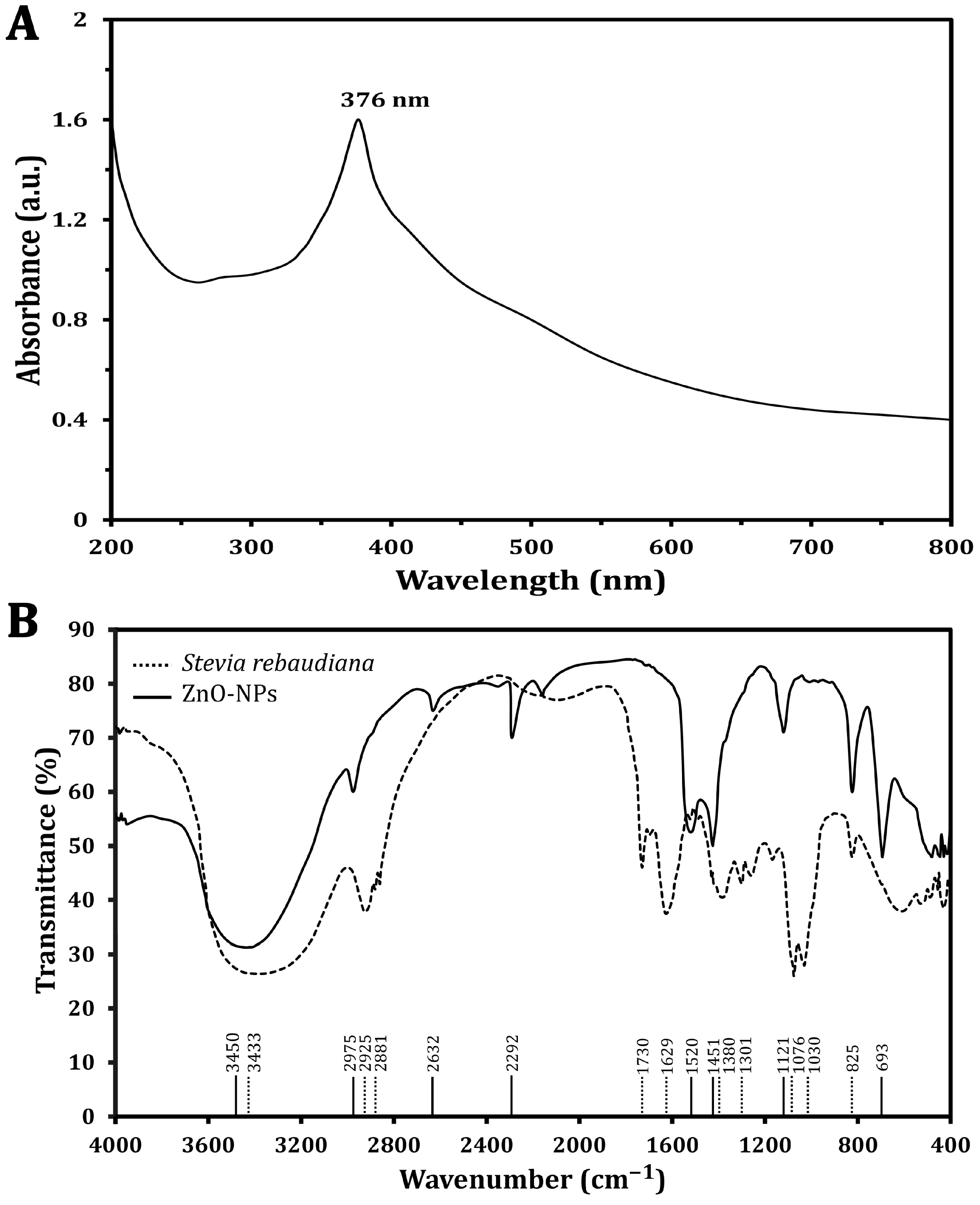
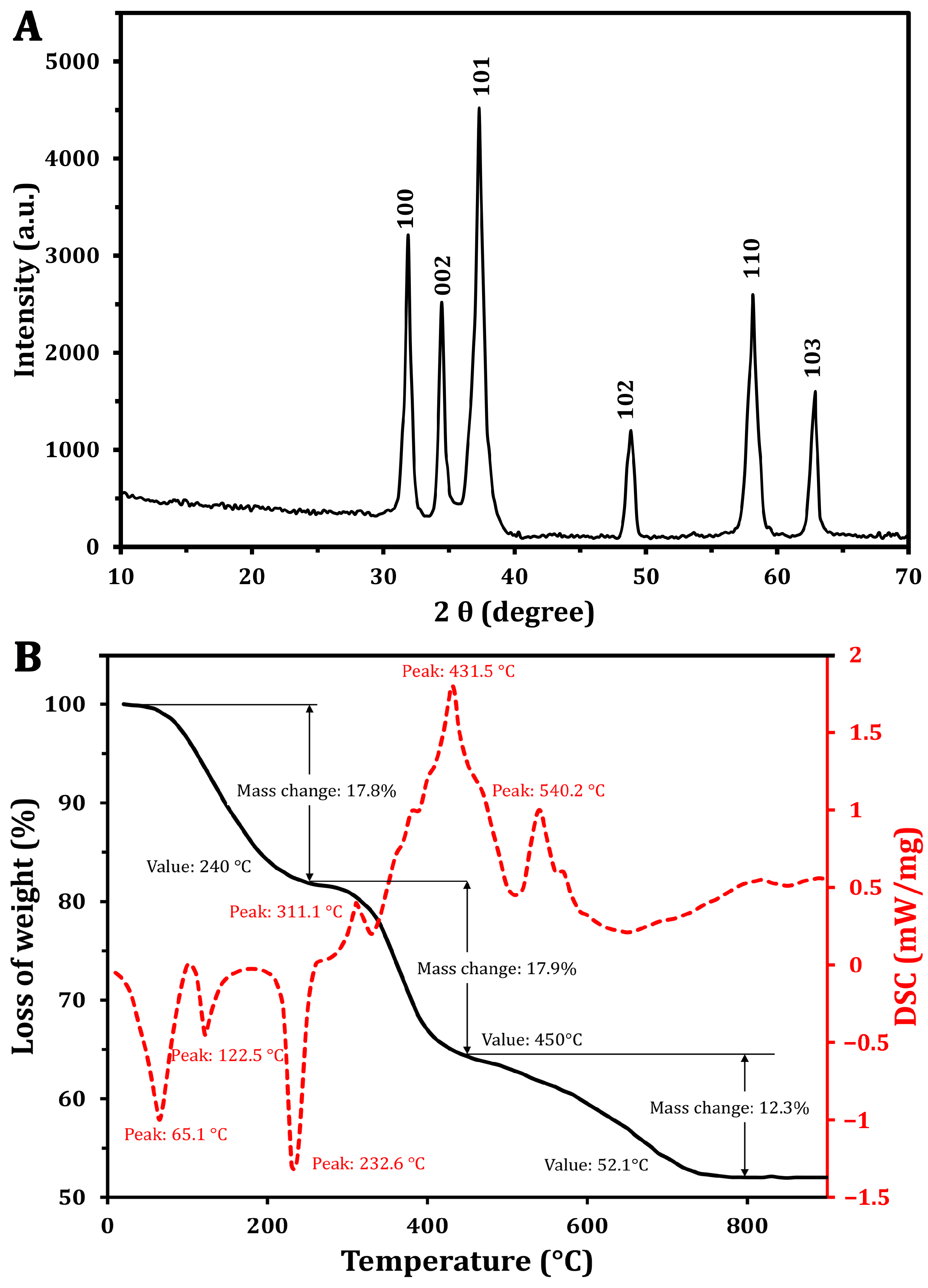
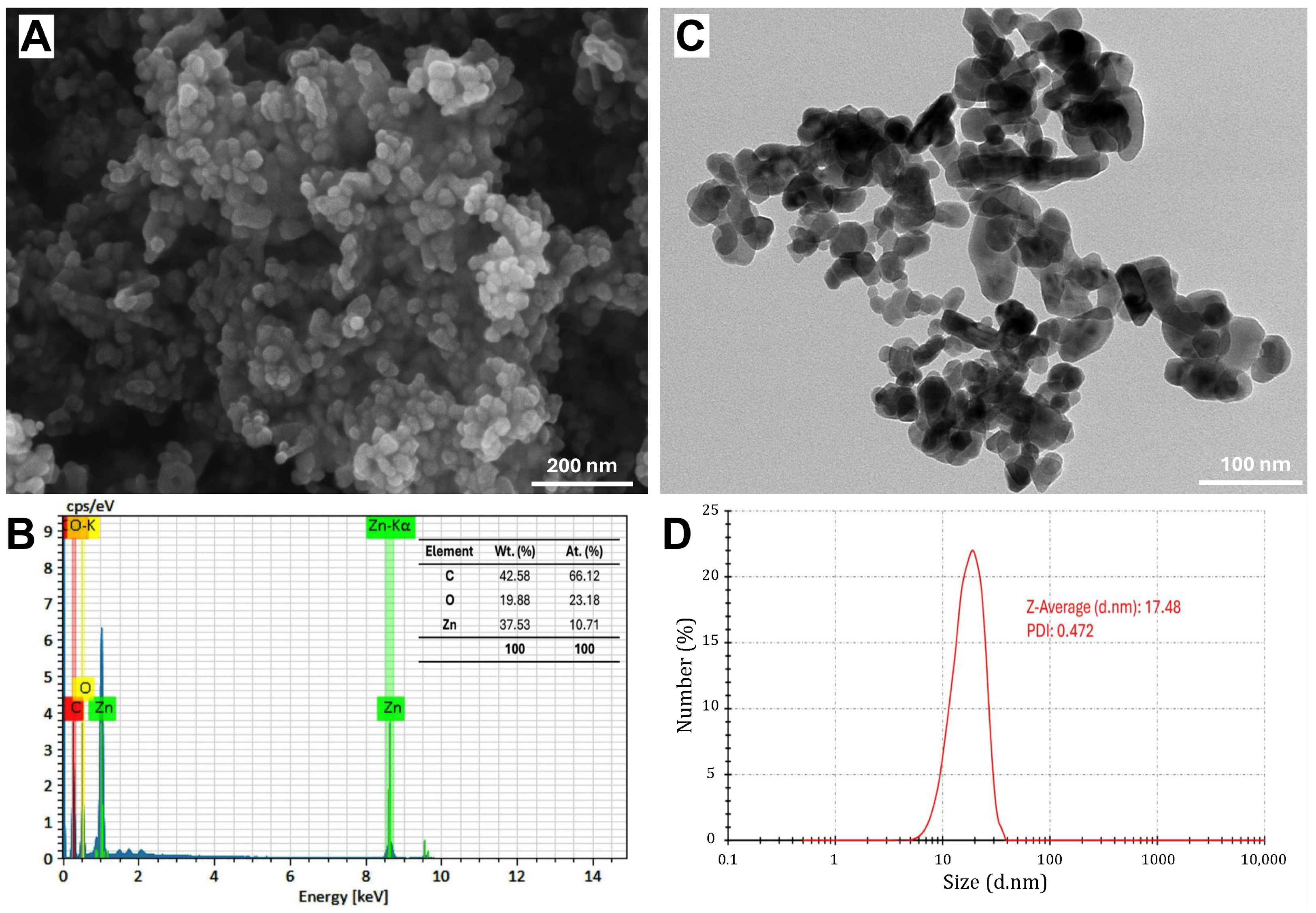
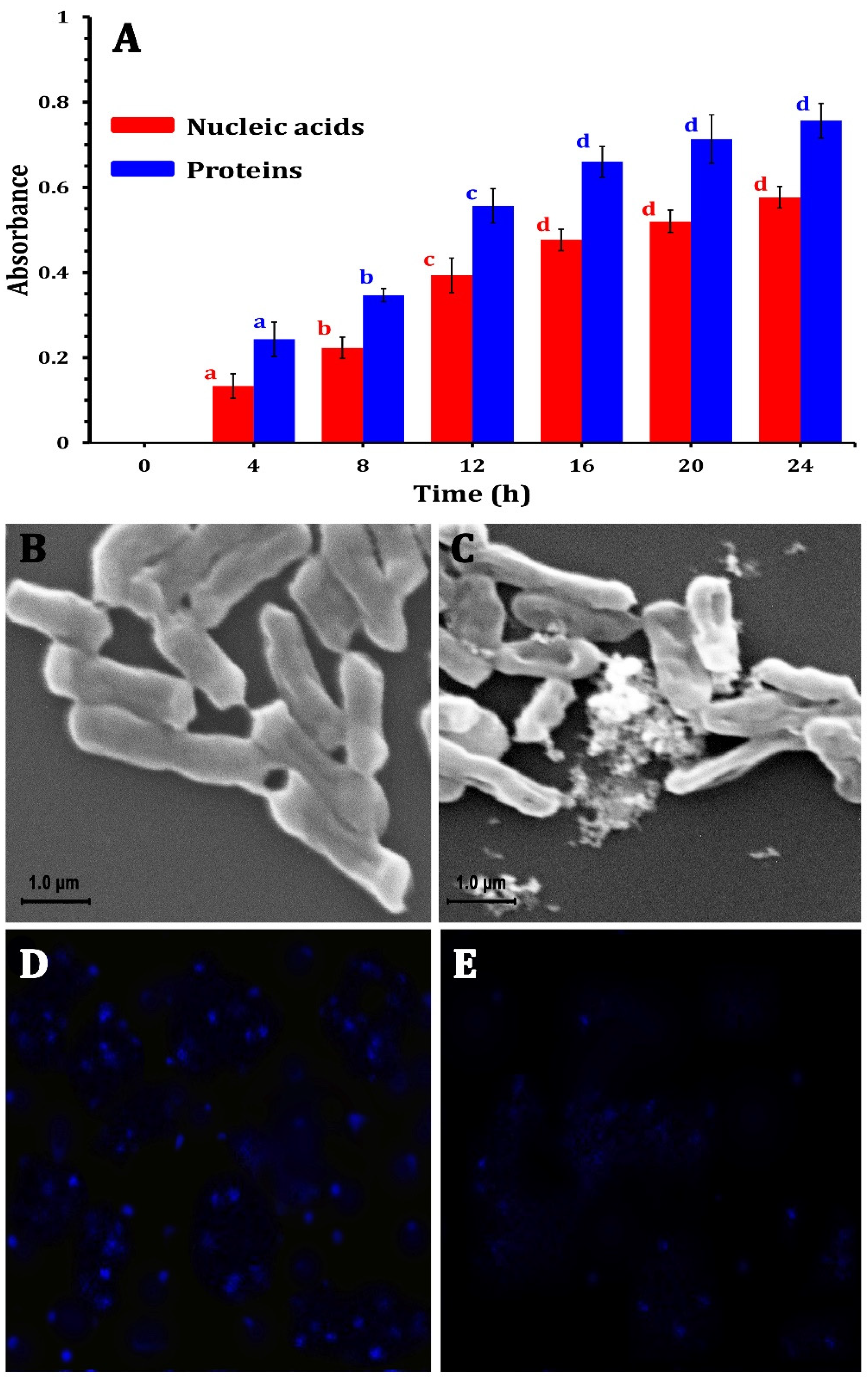
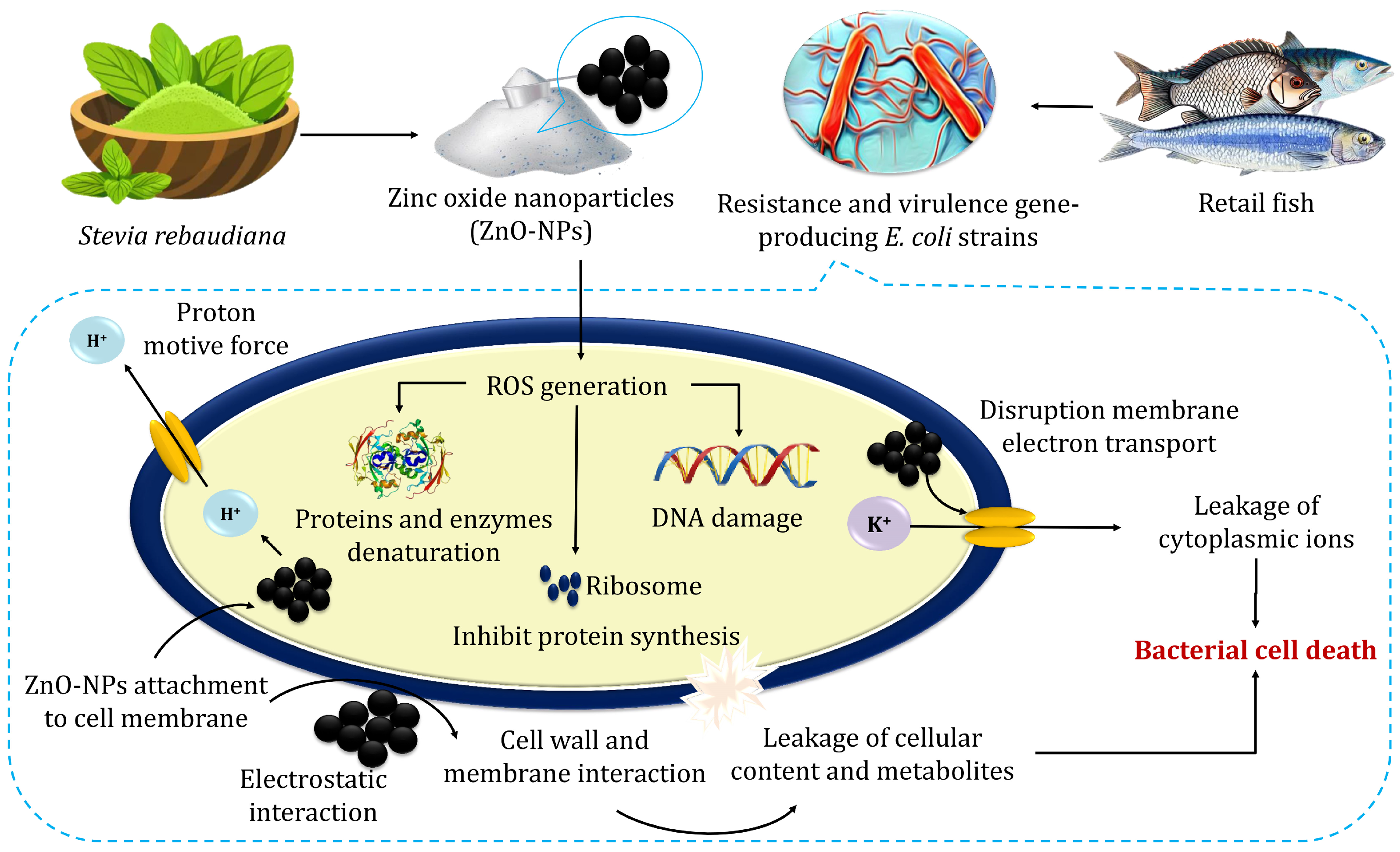
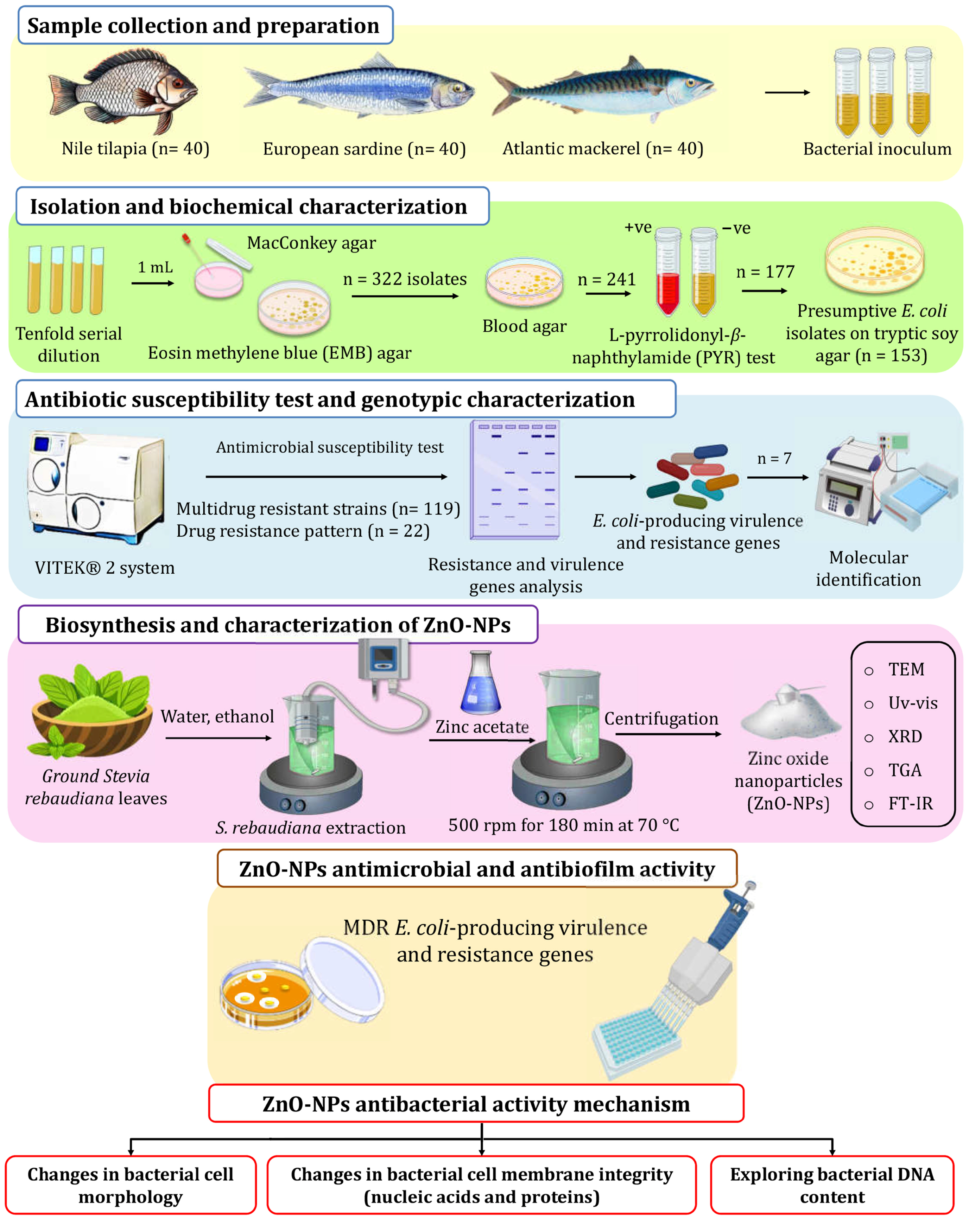
| Position (°2 θ) | Planes | FWHM Left (°2 θ) | Lattice Strain (ε) | Size (nm) |
|---|---|---|---|---|
| 31.87 | 100 | 0.62174 | 0.0016 | 12.41 |
| 34.44 | 002 | 0.52491 | 0.0012 | 14.68 |
| 37.29 | 101 | 0.94222 | 0.002 | 8.19 |
| 48.8 | 102 | 0.57847 | 0.001 | 13.32 |
| 58.13 | 110 | 0.89517 | 0.0012 | 8.68 |
| 62.8 | 103 | 0.58732 | 0.0007 | 13.18 |
| Average FWHM | 0.691638 | Average size | 11.74 | |
| Strain Code | ZnO-NPs and IZ (mm) * | MIC (µg/mL) | MBC (µg/mL) | |||
|---|---|---|---|---|---|---|
| 5 µg/Disk | 10 µg/Disk | 15 µg/Disk | 20 µg/Disk | |||
| MFEC-S-31 | 10.5 ± 0.5 abc ** | 13.7 ± 0.7 a | 14.6 ± 1.0 ab | 16.5 ± 1.5 ac | 25 | 50 |
| MFEC-NT-6 | 10.3 ± 0.8 abc | 13.1 ± 1.1 a | 15.3 ± 1.8 a | 17.7 ± 1.2 a | 12.5 | 25 |
| MFEC-S-34 | 11.5 ± 0.5 b | 13.5 ± 1.0 a | 15.5 ± 1.5 a | 18.3 ± 1.0 a | 12.5 | 25 |
| MFEC-M-1 | 8.2 ± 0.4 c | 10.5 ± 1.1 b | 14.6 ± 0.8 ab | 16.6 ± 0.8 ac | 25 | 50 |
| MFEC-S-2 | 9.6 ± 0.6 abc | 11.2 ± 1.2 b | 16.1 ± 1.1 a | 19.2 ± 1.6 b | 12.5 | 25 |
| MFEC-M-10 | 9.3 ± 0.6 abc | 10.8 ± 0.7 b | 12.9 ± 0.9 b | 14.5 ± 1.0 c | 32 | 64 |
| MFEC-NT-22 | 11.1 ± 1.0 ab | 12.5 ± 0.5 a | 14.2 ± 0.7 ab | 16.5 ± 0.5 ac | 25 | 50 |
| p-value | 0.905 | 0.809 | 0.876 | 0.837 | ||
| Strain Code | Biofilm Inhibition (%) | |||||
|---|---|---|---|---|---|---|
| 0 µg | 50 µg | 100 µg | 150 µg | 200 µg | 250 µg | |
| MFEC-S-31 | 0.0 ± 0.0 a * | 19.1 ± 1.1 ac | 41.5 ± 2.6 a | 64.1 ± 1.7 a | 70.0 ± 2.7 a | 82.4 ± 2.5 a |
| MFEC-NT-6 | 0.0 ± 0.0 a | 21.1 ± 0.8 abc | 43.2 ± 2.2 ad | 63.5 ± 2.0 a | 80.3 ± 1.6 b | 82.6 ± 3.1 a |
| MFEC-S-34 | 0.0 ± 0.0 a | 18.5 ± 0.7 ac | 40.1 ± 1.8 a | 63.4 ± 2.1 a | 79.2 ± 2.2 b | 81.3 ± 2.2 a |
| MFEC-M-1 | 0.0 ± 0.0 a | 22.3 ± 1.5 ac | 43.1 ± 2.5 ad | 65.5 ± 1.5 a | 81.3 ± 2.3 b | 84.3 ± 1.7 ac |
| MFEC-S-2 | 0.0 ± 0.0 a | 17.4 ± 1.3 c | 28.6 ± 1.4 b | 48.6 ± 1.6 b | 65.3 ± 1.5 c | 75.3 ± 2.4 b |
| MFEC-M-10 | 0.0 ± 0.0 a | 19.6 ± 0.6 ac | 33.4 ± 1.5 c | 52.6 ± 1.4 b | 70.4 ± 3.1 a | 80.3 ± 2.0 a |
| MFEC-NT-22 | 0.0 ± 0.0 a | 25.2 ± 1.4 b | 46.1 ± 2.4 d | 66.4 ± 2.1 a | 82.6 ± 2.8 b | 86.4 ± 3.4 c |
| p-value | 0.982 | 0.961 | 0.996 | 0.804 | 0.902 | 0.982 |
Disclaimer/Publisher’s Note: The statements, opinions and data contained in all publications are solely those of the individual author(s) and contributor(s) and not of MDPI and/or the editor(s). MDPI and/or the editor(s) disclaim responsibility for any injury to people or property resulting from any ideas, methods, instructions or products referred to in the content. |
© 2025 by the authors. Licensee MDPI, Basel, Switzerland. This article is an open access article distributed under the terms and conditions of the Creative Commons Attribution (CC BY) license (https://creativecommons.org/licenses/by/4.0/).
Share and Cite
Elabbasy, M.T.; El Bayomi, R.M.; Abdelkarim, E.A.; Hafez, A.E.-S.E.; Othman, M.S.; Ghoniem, M.E.; Samak, M.A.; Alshammari, M.H.; Almarshadi, F.A.; Elsamahy, T.; et al. Antibacterial and Antibiofilm Activity of Green-Synthesized Zinc Oxide Nanoparticles Against Multidrug-Resistant Escherichia coli Isolated from Retail Fish. Molecules 2025, 30, 768. https://doi.org/10.3390/molecules30040768
Elabbasy MT, El Bayomi RM, Abdelkarim EA, Hafez AE-SE, Othman MS, Ghoniem ME, Samak MA, Alshammari MH, Almarshadi FA, Elsamahy T, et al. Antibacterial and Antibiofilm Activity of Green-Synthesized Zinc Oxide Nanoparticles Against Multidrug-Resistant Escherichia coli Isolated from Retail Fish. Molecules. 2025; 30(4):768. https://doi.org/10.3390/molecules30040768
Chicago/Turabian StyleElabbasy, Mohamed Tharwat, Rasha M. El Bayomi, Esraa A. Abdelkarim, Abd El-Salam E. Hafez, Mohamed S. Othman, Mohamed E. Ghoniem, Mai A. Samak, Muteb H. Alshammari, Fahad Awwadh Almarshadi, Tamer Elsamahy, and et al. 2025. "Antibacterial and Antibiofilm Activity of Green-Synthesized Zinc Oxide Nanoparticles Against Multidrug-Resistant Escherichia coli Isolated from Retail Fish" Molecules 30, no. 4: 768. https://doi.org/10.3390/molecules30040768
APA StyleElabbasy, M. T., El Bayomi, R. M., Abdelkarim, E. A., Hafez, A. E.-S. E., Othman, M. S., Ghoniem, M. E., Samak, M. A., Alshammari, M. H., Almarshadi, F. A., Elsamahy, T., & Hussein, M. A. (2025). Antibacterial and Antibiofilm Activity of Green-Synthesized Zinc Oxide Nanoparticles Against Multidrug-Resistant Escherichia coli Isolated from Retail Fish. Molecules, 30(4), 768. https://doi.org/10.3390/molecules30040768









